The ape who learned to run (2): Run for your health but wisely.
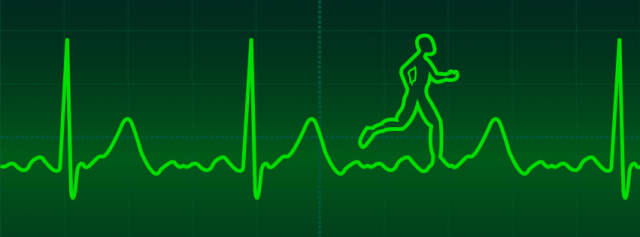
Running is an activity that humans have held for millennia. It has been a tool, a hobby or a fashion rose by needs, crisis, culture or marketing campaigns. Today, in a busy and sedentary society aware that to maintain health it is necessary to move the ass, running has become again a major way of exercising the body. Whether to burn kilos or to shoot up with endorphins, the last fashion wave of running last more than a decade winning more and more adepts. In my opinion there are three main reasons for that: generally it does the expected job and it is inexpensive in time and money (at least for average recreational runners).
However, although it might be that we were born to run and that running appears the easiest thing in the world, doing it right is not so easy or straightforward. On one hand, the press shows us the seemingly alarming increase in sudden deaths among amateur runners during popular races in the last years. On the hand, as result of this urge to run, injuries in lower limbs have increased considerably among the population practising recreational running.
The former problem seems to exist and derives mainly from occult cardiomyopathies and also from heat shocks (Yankelson et al. 2014). But contrary to what has been shown in mass media, the increase in sudden deaths among runners is far from being alarming, even more taking into account the 20-fold increase in marathon finishers within 1976 and 2011 only in USA. In this regard Jonathan H. Kim and co-workers reported in 2012 some enlightening findings that are supported by other studies. They collected the available data for cardiac arrest in races of marathon and half-marathon among 10.9 million registered participants within 2000 and 2010. Finding an overall incidence of cardiac arrest of 1 per 184,000 and sudden death (no survivors to the cardiac arrest) of 1.00 per 259,000 participants. The major cause was a hidden cardiac disease (Figure 1). Only among men the rate of incidences the last five years of the study was slightly higher (from 1.4/100000 to 2/100000). An estimation translates those overall rates in time references: for every 100,000 hours (4 years) running, there would be 0.2 cardiac arrests and 0.14 sudden deaths.
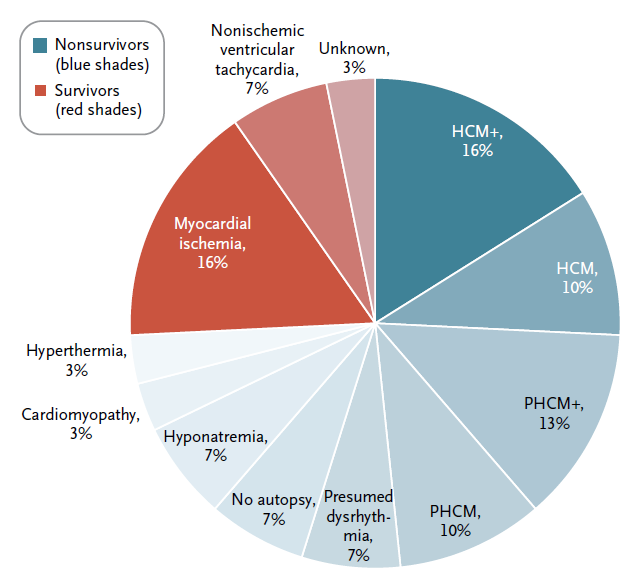
Therefore, a very low risk that should not persuade against cumulative evidence from health benefits of running. A study published in 2014 with more than 55.000 individuals illustrate this: all-cause mortality and cardiovascular mortality rates are significantly smaller in recreational runners than among those non-runners, independently of the time invested, speed and mileage per week running. Nevertheless, as it was already known, mileages over 35km/week or running every day may cause more heart problems than running bit less. Only 5 to 10 min/day at speeds close to 9km/h would be enough to have benefits (Figure 2).
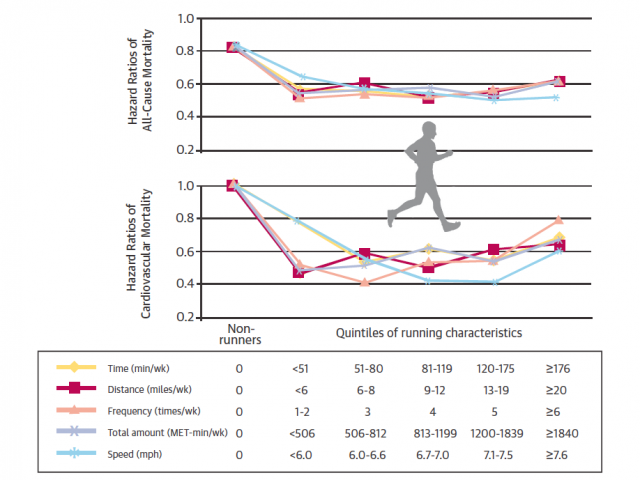
Therefore, an averaged healthy person that practices for that is cardiovascular and metabolically capable to run in 4 to 6 hours the not so flat 42km tracks in the US circuit (Figure 3) without significant life treating risk. Although it would not hurt to discard any cardiomyopathy or musculoskeletal problem visiting the doctor before engage any level of training or competition. Keeping always hydrated with isotonic liquids and avoiding extreme weather conditions is also paramount. However, training and race will generate impact loads (600 impacts approx. per km) on lower limbs. Inadequate ways of executing the running technique, which also results in deficient running economy, will result in greater impact loads that could lead to injury.
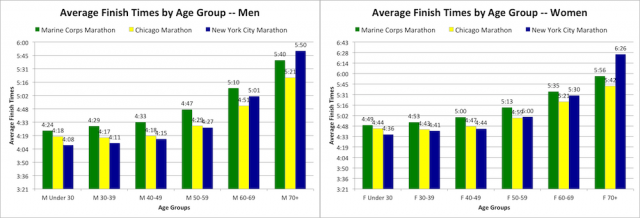
In that direction Lieberman and colleges advanced in 2010 key observations. Due to the modern highly cushioned running shoes invented in the seventies, today up to 80% of the endurance runners make land their fit on the heel (rear-foot strike (RFS)). However, when barefoot running (naked fit or shoed with little or no cushion), most of the runners adopt middle-foot strike (MFS) or forefoot strike (FFS). When RFS is used either barefoot or in cushioned shoes, the impact forces are approximately three times higher than FFS (Figure 4). Additionally, the rate of loading, which measures the speed with which the force is applied (on the tissues in this case), it is away lower in forefoot strike runners. In a later work Daoud came to show that rates of repetitive stress injury are significantly higher among rear-foot strike runners than on forefoot strike runners 1. Therefore, pointing out those high impact forces and rates of loading during RFS as source of some injuries suffered by a high percentage of runners nowadays.
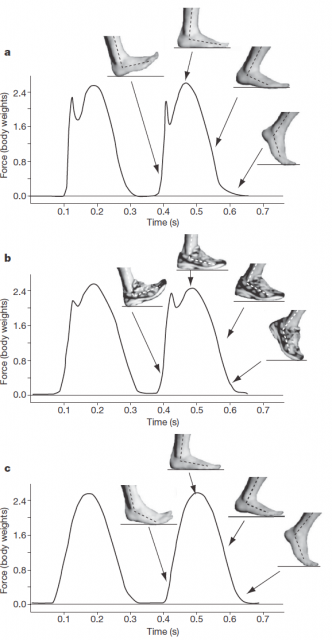
Nevertheless, there is still limited scientific documentation regarding the issue, which has unleashed a host of beliefs among those who run out of passion or engaged in running by profession. There are countless convictions about how to suffer fewer injuries while being more efficient at running. Running using forefoot strike is, for the moment, among those beliefs. In support of this, the effect of using fore-foot strike for running has been reported recently to be effective for pain reduction and healing in lower limb injuries in small courts of retrained runners that used rear-foot strike before (Diebal et al. 2012, Willy et al. 2014, Roper et al. 2016, Barton et al. 2016).
However, Isabel S. Moore reviewed early this year the current evidence about running technique factors involved in increasing running economy (RE) and FFS it is not among them (in some cases it has been shown even detrimental)2. In fact, factors like less leg extension at toe-off, larger stride angles, shorter stride length but higher stride frequency, alignment of the ground reaction force and leg axis, low activation of the lower limb muscles, higher leg stiffness and lower vertical oscillation seem to contribute to better running economy. Additionally it seems that running with light shoes (<440g/pair bearing medium to low level of cushioning) or barefoot improves the RE. Though remains unclear way light footwear with little cushioning or the lack of it have this effect, given that running barefoot can modify several of the above running biomechanical factors apart of switching from RFS to FFS. Furthermore, most the faster elite endurance runners display MFS or FFS, accomplishing in general most of the factors above for high RE. Thus making appealing to average runners to retrain the global running technique in order to be faster while reducing injuries. Nevertheless, many of the documented attempts done on retraining recreational runners have fail on improving the RE, which is quite likely due to short periods of training used for changing so many factors.
Therefore, it could be said, according with the current evidence, that running is normally safe and beneficial for our cardiovascular system and general health within fairly wide limits of distance, time invested and speed; albeit overtraining and extreme weekly mileage should be avoided. Implementing the factors necessary for an efficient running technique and adopting middle or fore-foot strike (regardless of barefoot y showed) would be desirable for reducing injuries and unnecessary fatigue, but it should not become an obsession. It appears that to acquire a good running technique takes time and patience (and probably specialized supervision). Even more, if you have already acquired “bad habits running”, be aware that trying to get a good running form quickly could also lead to injury. Hence, if you want to enjoy running, one of the best and briefest advices one can give (I heard it from Francisco Contreras, a 77 years old Ultramarathon runner) is that running is not hard; it is hard for those who want to run more than they are able, everyone must adapt his effort.